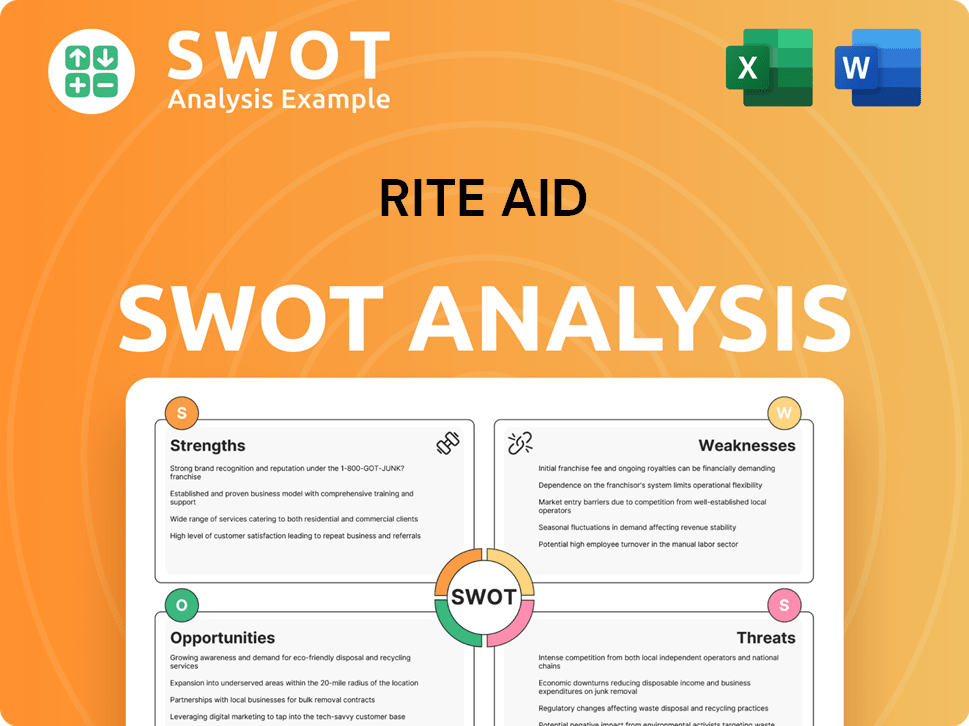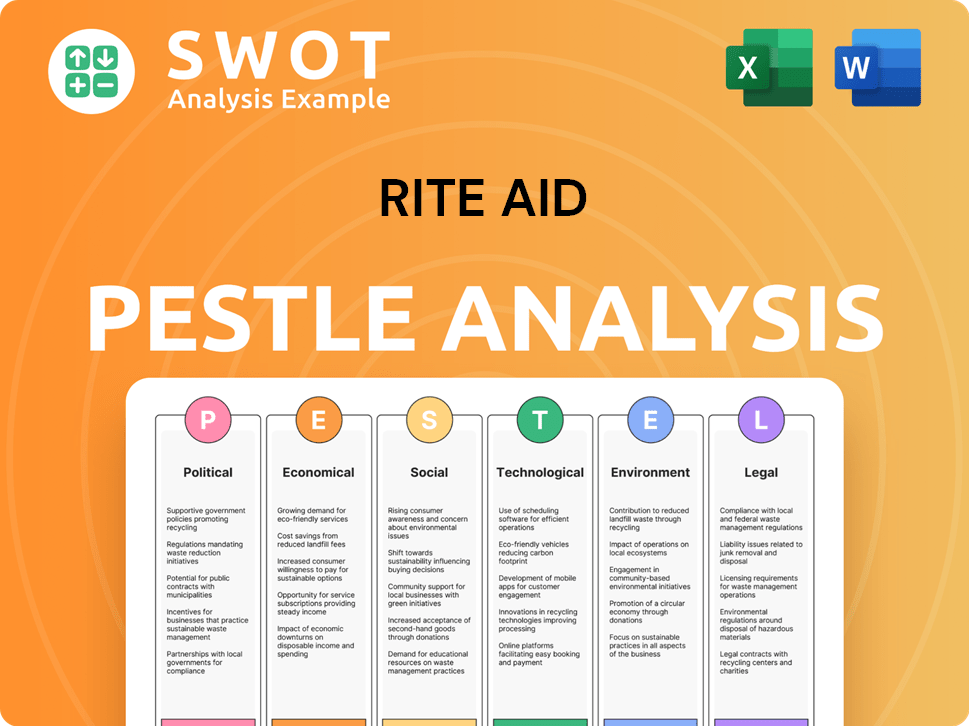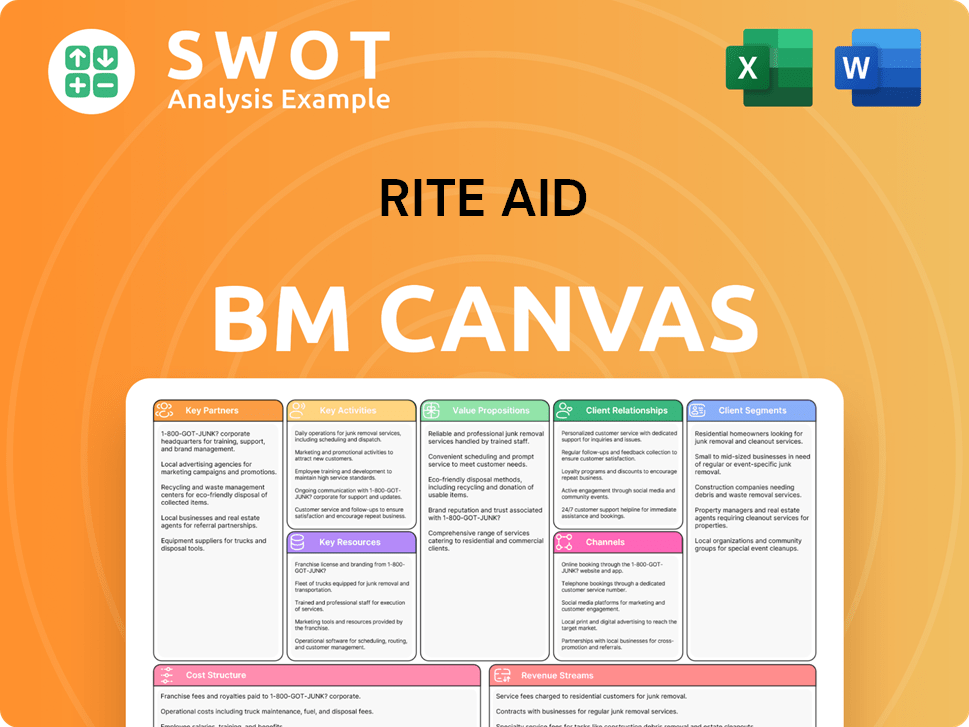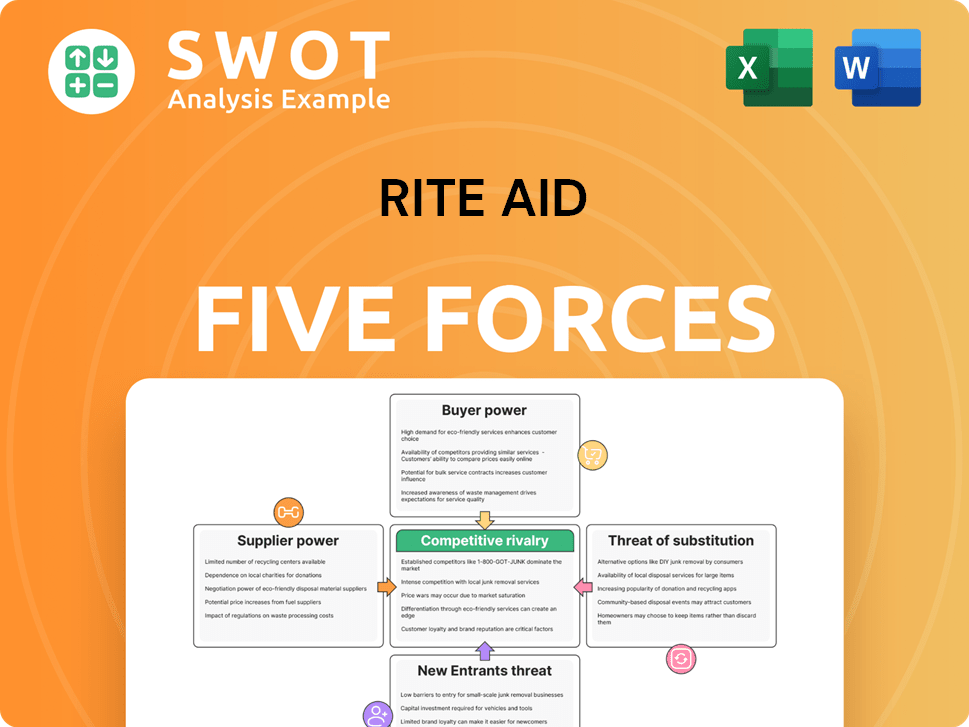Rite Aid Bundle
Can Rite Aid Thrive in Today's Pharmacy Wars?
The U.S. pharmacy retail sector is a battlefield of shifting consumer preferences, technological leaps, and evolving healthcare models. Rite Aid, a veteran of this arena since 1962, has consistently adapted to survive. From its origins as a discount retailer to its current focus on comprehensive healthcare, Rite Aid's journey is a testament to its resilience.

To understand Rite Aid's position, we must dissect its Rite Aid SWOT Analysis and examine its competitive landscape. This analysis provides a deep dive into the primary players in the pharmacy industry, their strategies, and how Rite Aid stacks up against its competitors. We'll explore Rite Aid's market share analysis, recent acquisitions, and the challenges it faces in this dynamic retail pharmacy environment, including a close look at Rite Aid vs CVS comparison and Rite Aid and Walgreens dynamics. This will allow us to understand Rite Aid's financial performance and future outlook.
Where Does Rite Aid’ Stand in the Current Market?
Rite Aid operates as a significant player within the U.S. retail pharmacy sector. Its core business revolves around prescription fulfillment, which is a primary revenue driver. The company also offers a wide array of over-the-counter medications, health and beauty products, personal care items, and general merchandise, positioning it as a one-stop shop for health and wellness needs. Additionally, through its subsidiary, Elixir, Rite Aid provides pharmacy benefit management (PBM) services, expanding its reach in the healthcare market.
The value proposition of Rite Aid centers on providing accessible healthcare services and products to local communities. It aims to differentiate itself through personalized pharmacy services and a focus on wellness programs. Rite Aid strives to be a convenient and trusted healthcare destination, offering a combination of pharmacy services and retail products to meet customer needs. However, the Growth Strategy of Rite Aid has been challenged by market dynamics.
Geographically, Rite Aid's presence is concentrated in the East Coast and certain regions of the West Coast of the United States. The company has been adapting to market consolidation and increased competition, particularly from larger drugstore chains. The market position of Rite Aid has faced pressures in recent years, influencing its financial performance and strategic decisions.
Rite Aid generally ranks as one of the larger pharmacy chains in the United States. However, specific market share figures are subject to change due to competitive disclosures and market fluctuations. It typically trails behind industry leaders like CVS Health and Walgreens Boots Alliance in terms of market share.
Rite Aid has faced significant financial challenges. For the fiscal third quarter ended December 2, 2023, the company reported a net loss of $590.2 million. Total revenues for the same quarter were $6.2 billion, a decrease of 7.9% compared to the prior year's third quarter, highlighting the financial strain.
Rite Aid has been actively engaged in bankruptcy proceedings, which further underscores its challenged market position. This situation reflects the intense competitive pressures and financial difficulties the company has been navigating as of late 2023 and early 2024.
The Rite Aid competitive landscape includes major players like CVS Health and Walgreens, along with other regional and national pharmacy chains. Competition extends to online pharmacies and other healthcare providers. The pharmacy industry is highly competitive, with companies constantly vying for market share.
Several factors influence Rite Aid's market position, including competitive pressures, financial performance, and strategic initiatives. The company's ability to adapt to changing market dynamics and consumer preferences is crucial for its survival. Understanding these factors is essential for a comprehensive Rite Aid market analysis.
- Intense competition from larger pharmacy chains such as CVS and Walgreens.
- Financial challenges, including significant net losses and revenue declines.
- Strategic initiatives to improve customer experience and expand service offerings.
- Bankruptcy proceedings impacting operations and future outlook.
Rite Aid SWOT Analysis
- Complete SWOT Breakdown
- Fully Customizable
- Editable in Excel & Word
- Professional Formatting
- Investor-Ready Format

Who Are the Main Competitors Challenging Rite Aid?
The Owners & Shareholders of Rite Aid face a challenging competitive landscape. The company contends with a diverse array of competitors in both its retail pharmacy and pharmacy benefit management (PBM) segments. Understanding these competitors is crucial for assessing Rite Aid's market position and future prospects.
The primary competitors in the retail pharmacy sector, such as CVS Health and Walgreens Boots Alliance, present significant challenges due to their extensive networks, integrated healthcare services, and aggressive market strategies. Additionally, Rite Aid competes with supermarket chains, mass merchandisers, and online pharmacies, each leveraging unique strengths to capture market share. The PBM sector adds another layer of complexity, with major players like OptumRx and Express Scripts vying for dominance.
The competitive dynamics are continuously evolving, influenced by industry trends such as consolidation, digital health solutions, and omnichannel retail experiences. Rite Aid's ability to navigate these challenges and adapt to changing consumer preferences will be critical for its long-term success.
Rite Aid's most significant direct competitors are CVS Health and Walgreens Boots Alliance. These drugstore chains possess extensive retail footprints and comprehensive pharmacy offerings.
CVS Health, with its vast network of pharmacies and MinuteClinic walk-in clinics, presents a formidable challenge. CVS Caremark, its PBM segment, further strengthens its market position. CVS Health has a substantial market share within the pharmacy industry.
Walgreens Boots Alliance, another major player, boasts a broad retail presence and a comprehensive pharmacy offering. They are also expanding partnerships in healthcare services. Walgreens has a significant market share and a large customer base.
Rite Aid also faces competition from indirect sources, including supermarket chains and mass merchandisers that offer pharmacy services. Online pharmacies are an emerging threat.
Walmart and Kroger, with integrated pharmacies, provide the convenience of one-stop shopping. Target also offers pharmacy services, leveraging its broader retail appeal. These competitors often attract customers with competitive pricing and convenience.
Online pharmacies, such as Amazon Pharmacy, challenge traditional brick-and-mortar models. They offer convenience, competitive pricing, and direct-to-consumer delivery. The online pharmacy market is experiencing rapid growth.
In the PBM sector, Rite Aid's Elixir competes with large players. These competitors have significant market share, advanced technology, and extensive client relationships. The PBM landscape is marked by consolidation and technological advancements.
- OptumRx (UnitedHealth Group): A major player with a substantial market share and advanced technological capabilities.
- Express Scripts (Cigna): Possesses a large client base and significant influence in the PBM market.
- CVS Caremark: Leverages its integrated healthcare services to compete effectively.
- Independent Pharmacies: Differentiate through personalized service and community ties.
Rite Aid PESTLE Analysis
- Covers All 6 PESTLE Categories
- No Research Needed – Save Hours of Work
- Built by Experts, Trusted by Consultants
- Instant Download, Ready to Use
- 100% Editable, Fully Customizable

What Gives Rite Aid a Competitive Edge Over Its Rivals?
Analyzing the competitive landscape of Rite Aid reveals a company navigating a challenging market. Rite Aid's competitive advantages have historically included established regional presence and customer loyalty. However, the drugstore chain faces significant pressures from larger competitors and evolving industry dynamics. Understanding these factors is crucial for a thorough Rite Aid market analysis.
Rite Aid's strategic moves and financial performance are vital in assessing its position within the pharmacy industry. The company has aimed to differentiate itself through personalized pharmacy services and its pharmacy benefit management (PBM) subsidiary, Elixir. Despite these efforts, Rite Aid's future outlook is subject to the scale and strategies of its rivals, as well as its own financial restructuring.
The competitive landscape of Rite Aid includes a complex interplay of factors impacting its ability to compete effectively. Its ability to leverage its distribution networks and enhance its digital presence are critical. This chapter delves into the specific competitive advantages, challenges, and industry trends shaping Rite Aid's position in the retail pharmacy sector. For more insights, explore the Growth Strategy of Rite Aid.
Rite Aid has historically held a strong presence in specific regions, particularly on the East Coast, fostering brand recognition. This established footprint allowed the company to build customer loyalty and trust within local communities. This regional focus has been a key element in its competitive strategy within the drugstore chains market.
Rite Aid has emphasized personalized pharmacy services, positioning its pharmacists as accessible healthcare professionals. This strategy aims to build stronger customer relationships compared to larger, more transactional competitors. By focusing on community health and patient interaction, Rite Aid seeks to differentiate itself.
Rite Aid's ownership of Elixir, its pharmacy benefit management (PBM) subsidiary, provides a degree of vertical integration. This allows Rite Aid to capture more of the healthcare spend and potentially drive prescription volume to its retail pharmacies. While the PBM market is competitive, Elixir expands Rite Aid's healthcare footprint.
Rite Aid has leveraged its distribution networks for product availability and efficient supply chain operations. The company has also made efforts to enhance its digital presence and omnichannel capabilities to improve customer convenience. These efforts are crucial for remaining competitive.
Rite Aid faces significant challenges in the competitive landscape, including the scale and strategies of larger rivals. The company's financial performance has been under pressure, impacting its ability to invest in growth initiatives. Understanding these challenges is essential for a complete Rite Aid SWOT analysis.
- Competition: The drugstore chains market is highly competitive, with CVS, Walgreens, and others having significant market share.
- Financial Restructuring: Rite Aid has undergone financial restructuring, impacting its operations and strategic flexibility.
- Industry Trends: Evolving industry trends, such as the growth of online pharmacies and changing consumer preferences, pose challenges.
- Market Share: Rite Aid's market share analysis shows a decline in recent years, reflecting the pressures it faces.
Rite Aid Business Model Canvas
- Complete 9-Block Business Model Canvas
- Effortlessly Communicate Your Business Strategy
- Investor-Ready BMC Format
- 100% Editable and Customizable
- Clear and Structured Layout

What Industry Trends Are Reshaping Rite Aid’s Competitive Landscape?
The retail pharmacy sector is currently undergoing significant transformations, impacting companies like Rite Aid. Digital health solutions, including telehealth and online prescription services, are becoming increasingly important. Regulatory changes and shifting consumer preferences towards personalized health and wellness solutions are also key drivers within the pharmacy industry.
For Rite Aid, navigating these trends involves significant challenges, including its ongoing bankruptcy proceedings, which began in October 2023. This situation has led to store closures and heightened competition from larger drugstore chains and e-commerce giants, affecting its Rite Aid market share analysis and overall financial health. Understanding the Rite Aid competitive landscape is crucial for assessing its future prospects.
The pharmacy industry is seeing a rise in digital health services, including telehealth and online prescription fulfillment. Regulatory changes, particularly those affecting drug pricing and data privacy, are constantly reshaping the market. Consumers increasingly seek personalized health solutions and preventative care, moving beyond simple prescription fulfillment.
Rite Aid's bankruptcy proceedings, initiated in October 2023, present a major hurdle. The company faces intense competition from larger rivals like CVS Health and Walgreens, as well as e-commerce entrants. Store closures, with over 200 locations closed or slated to close as of early 2024, impact its footprint and revenue.
Rite Aid could leverage its remaining community presence to offer specialized healthcare services, such as immunizations and chronic disease management. Expanding its PBM services through Elixir and forming strategic partnerships are also potential growth avenues. Innovation in service delivery and operational streamlining are key.
The Rite Aid competitive landscape is dominated by larger players like CVS and Walgreens. Amazon's entry into the pharmacy space has intensified competition. Rite Aid must differentiate itself to survive, focusing on operational efficiency, innovation, and strategic partnerships. For more information on how Rite Aid can improve, you can check out the Marketing Strategy of Rite Aid.
Rite Aid's future depends heavily on its ability to restructure successfully and adapt to market changes. Key factors include debt reduction, service innovation, and effective differentiation strategies. The company's ability to navigate these challenges will determine its long-term viability in the pharmacy industry.
- Successful restructuring to reduce debt and streamline operations.
- Expansion of services beyond traditional prescription dispensing.
- Strategic partnerships to enhance service offerings and market reach.
- Focus on digital health solutions to meet evolving consumer demands.
Rite Aid Porter's Five Forces Analysis
- Covers All 5 Competitive Forces in Detail
- Structured for Consultants, Students, and Founders
- 100% Editable in Microsoft Word & Excel
- Instant Digital Download – Use Immediately
- Compatible with Mac & PC – Fully Unlocked

Related Blogs
- What are Mission Vision & Core Values of Rite Aid Company?
- What is Growth Strategy and Future Prospects of Rite Aid Company?
- How Does Rite Aid Company Work?
- What is Sales and Marketing Strategy of Rite Aid Company?
- What is Brief History of Rite Aid Company?
- Who Owns Rite Aid Company?
- What is Customer Demographics and Target Market of Rite Aid Company?
Disclaimer
All information, articles, and product details provided on this website are for general informational and educational purposes only. We do not claim any ownership over, nor do we intend to infringe upon, any trademarks, copyrights, logos, brand names, or other intellectual property mentioned or depicted on this site. Such intellectual property remains the property of its respective owners, and any references here are made solely for identification or informational purposes, without implying any affiliation, endorsement, or partnership.
We make no representations or warranties, express or implied, regarding the accuracy, completeness, or suitability of any content or products presented. Nothing on this website should be construed as legal, tax, investment, financial, medical, or other professional advice. In addition, no part of this site—including articles or product references—constitutes a solicitation, recommendation, endorsement, advertisement, or offer to buy or sell any securities, franchises, or other financial instruments, particularly in jurisdictions where such activity would be unlawful.
All content is of a general nature and may not address the specific circumstances of any individual or entity. It is not a substitute for professional advice or services. Any actions you take based on the information provided here are strictly at your own risk. You accept full responsibility for any decisions or outcomes arising from your use of this website and agree to release us from any liability in connection with your use of, or reliance upon, the content or products found herein.